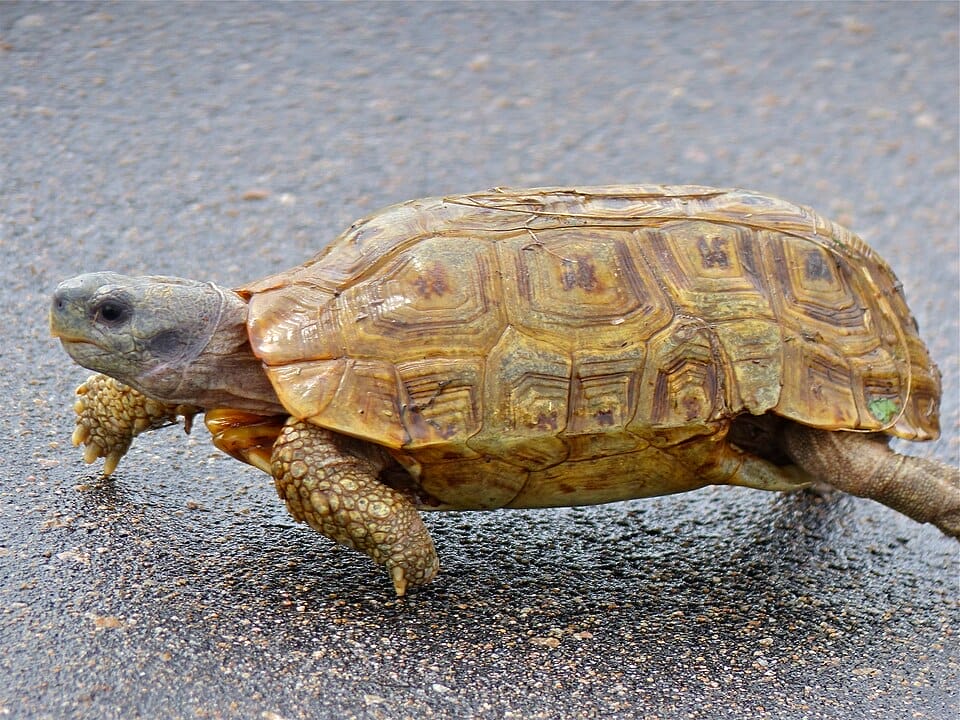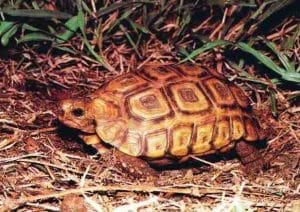Kinixys spekii (Speke’s Hinge-back Tortoise)
Home > Turtle Database > Kinixys spekii (Speke’s Hinge-back Tortoise)
Kinixys spekii, commonly known as Speke’s hinge-back tortoise, is a unique species native to parts of Eastern and Southern Africa. Distinguished by its hinged shell, this tortoise can protect itself by closing the rear portion of its carapace—a feature that sets it apart from many other tortoise species. Its adaptability and intriguing behaviors make it a subject of interest among herpetologists and nature enthusiasts alike.
Native To These Regions
Angola, Botswana, Democratic Republic of the Congo, Malawi, Mozambique, Namibia, South Africa, Tanzania, Zambia, ZimbabweNative Turtle Species Map – Find Turtles by Region
Scientific Classification
- Kingdom: Animalia
- Phylum: Chordata
- Class: Reptilia
- Order: Testudines
- Family: Testudinidae
- Genus: Kinixys
- Species: Kinixys spekii
Common Names
- Speke’s hinge-back tortoise
This Hilarious Turtle Book Might Know Your Pet Better Than You Do
Let’s be real—most turtle care guides feel like reading a textbook written by a sleep-deprived zookeeper.
This one’s not that.
Told from the snarky point of view of a grumpy, judgmental turtle, 21 Turtle Truths You’ll Never Read in a Care Guide is packed with sarcasm, sass, and surprisingly useful insights.
And hey—you don’t have to commit to the whole thing just yet.
Grab 2 free truths from the ebook and get a taste of what your turtle really thinks about your setup, your food choices, and that weird plastic palm tree.
It’s funny, it’s honest, and if you’ve ever owned a turtle who glares at you like you’re the problem—you’ll feel seen.
Identification
Description
Speke’s hinge-back tortoise is a medium-sized tortoise, with adults typically measuring 15 to 20 centimeters in carapace length. The carapace is elongated and brown to yellowish-brown, often featuring darker markings. A distinctive hinge at the rear of the carapace allows the tortoise to close its shell, protecting its hind limbs and tail from predators. The plastron (the underside of the shell) is lighter in color, and the skin ranges from gray to brown. It has a small head with a pointed snout and dark eyes.
Sexual Dimorphism
Sexual dimorphism is subtle in this species. Males generally have a slightly longer and thicker tail compared to females. Additionally, males may exhibit a concave plastron, which assists during mating, while females have a flatter plastron.
Check more turtles from the Kinixys genus
Native Origin and Distribution
Geographical Range
Speke’s hinge-back tortoise is found across several countries in Eastern and Southern Africa, including:
- Zimbabwe
- Mozambique
- Malawi
- Tanzania
- Zambia
- Democratic Republic of the Congo
Preferred Habitat
This species inhabits savannas, open woodlands, and areas near marshes or rivers. It prefers environments that offer ample ground cover, such as leaf litter and grasses, which provide protection and foraging opportunities. The tortoise is also known to utilize burrows to escape extreme temperatures and predators.
Behavior
Feeding Habits
Primarily herbivorous, Speke’s hinge-back tortoise feeds on a variety of vegetation, including grasses, leaves, fruits, and flowers. It may also consume fungi and occasionally small invertebrates, making its diet slightly omnivorous. Feeding typically occurs during cooler parts of the day to avoid overheating.
Predators
Natural predators include:
- Birds of Prey: Eagles and hawks may prey on juveniles.
- Mammals: Mongooses and wild dogs can pose a threat.
- Humans: Habitat destruction and collection for the pet trade are significant threats.
Reproduction
Breeding Season
Breeding usually takes place during the rainy season when food is abundant. Increased humidity and temperature appear to stimulate reproductive activities.
Reproductive Method
Females lay between 2 to 6 eggs in nests dug into the soil. The incubation period ranges from 90 to 120 days, depending on environmental conditions. Hatchlings are independent from birth and receive no parental care.
Conservation
Extinction Status
- IUCN Red List: Not Evaluated
Threats
- Habitat Loss: Due to agriculture and deforestation.
- Illegal Trade: Collection for the pet industry.
- Climate Change: Alters their habitat and food availability.
Conservation Measures
- Legal Protection: Enforcement of wildlife trade regulations.
- Habitat Preservation: Establishment of protected areas.
- Public Awareness: Education programs highlighting the species’ ecological role.
Economic Importance
While not a major economic asset, Speke’s hinge-back tortoise has value in:
- Ecotourism: Attracting nature enthusiasts to its natural habitats.
- Pet Trade: Although illegal collection is a concern, regulated trade can contribute economically if managed sustainably.
Interesting Facts
- Named After an Explorer: The species is named in honor of John Hanning Speke, a British explorer of Africa.
- Unique Shell Mechanism: The hinge-back feature is an evolutionary adaptation for enhanced protection.
- Aestivation Behavior: During extreme dry seasons, the tortoise may enter a state of dormancy to conserve water and energy.

About Author
Muntaseer Rahman started keeping pet turtles back in 2013. He also owns the largest Turtle & Tortoise Facebook community in Bangladesh. These days he is mostly active on Facebook.















